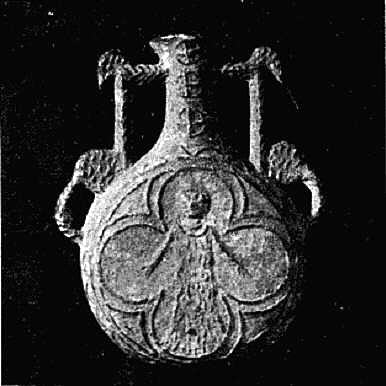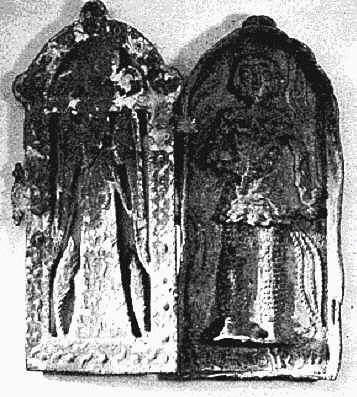 Fig. 2: a more
ambitious forgery, which may have been copied from a genuine
medieval ampulla.
(Courtesy Cuming Museum)
Not surprisingly, the appearance of so many artefacts of a
type hitherto unknown aroused suspicion. Henry Syer Cuming of
Southwark, secretary to the British Archaeological Association,
and Thomas Bateman, the Peak District archaeologist, were
dubious of the examples they saw, and corresponded on exposing
the fraud. Their scepticism was shared by the keepers at the
British Museum5. In March 1858 The Gentleman's
Magazine compared the objects to children's toys and dismissed
them as "almost worthless"6.
By the end of March Henry Syer Cuming had discovered how the
objects were being made. "The game is now almost up, and it is
high time it should be" he wrote7. On 28th April he
lectured on the finds to the British Archaeological Association.
He said that 12,000 has appeared. This was an exaggeration, but
does suggest the speed with which they had circulated and the
interest they had attracted. He pointed out the anachronisms in
their designs, described the crude way in which they had been
manufactured, and concluded by condemning
5. Southwark
Local Studies Library, Ms. 4565; T.B.A.C., 15th Feb. & 2nd April
1858.
6. March 1858 234.
7. T.B.A.C. 29th March 1858.
8. June 1858 649-50.
9. 8th May 1858 595.
10. August 1858 98.
11.T.B.A.C. 4th
Aug. 1858.
12. Proc Soc Ant Lond I ser
4 (1858) 209; Trans London Middlesex Archaeol Soc
1 (1858) 312.
|
them as a "Gross attempt at deception" and regretting that
there were no legal methods of punishing the forgers.
The lecture was not published in the Journal of the
Association, but it was reported in The Gentleman's Magazine8
and Athenaeum9. Sales declined rapidly, and
George Eastwood wrote to The Gentleman's Magazine
assuring the readers of the authenticity of his stock"10.
Meanwhile the eminent archaeologist Charles Roach Smith
inspected the finds. By 1858 he had retired from public life,
but his reputation was still very high. He was not sure what the
objects were, but he felt that they belonged to the 16th
century, partly on the logic that no forger would create
anything so preposterous. If they were forgeries, he wrote, they
would be "The most extraordinary insults that ever were offered
to the judgments of collectors this century"11. The
Reverend Thomas Hugo, vicar of St. Botolph's Bishopsgate, also
took an interest in the finds, believing them to be varieties of
pilgrims' signs12.
But the debate moved away
from academic speculation when George Eastwood sued the
publishers of Athenaeum for libel. He claimed that they
had published an article which accused him of selling forgeries,
for although he was not named, he

Fig. 3: another ambitious forgery - a small shrine.
Courtesy Curving Museum
|

